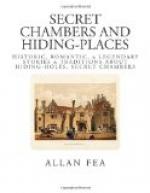Coxton Tower, near Elgin, contains a singular provision for communication from the top of the building to the basement, perfectly independent of the staircase. In the centre of each floor is a square stone which, when removed, reveals an opening from the summit to the base of the tower, through which a person could be lowered.
Another curious old Scottish mansion, famous for its secret chambers and passages, is Gordonstown. Here, in the pavement of a corridor in the west wing, a stone may be swung aside, beneath which is a narrow cell scooped out of one of the foundation walls. It may be followed to the adjoining angle, where it branches off into the next wall to an extent capable of holding fifty or sixty persons. Another large hiding-place is situated in one of the rooms at the back of a tall press or cupboard. The space in the wall is sufficiently large to contain eight or nine people, and entrance to it is effected by unloosing a spring bolt under the lower shelf, when the whole back of the press swings aside.
Whether the mystery of the famous secret room at Glamis Castle, Forfarshire, has ever been solved or satisfactorily explained beyond the many legends and stories told in connection with it, we have not been able to determine. The walls in this remarkable old mansion are in parts over twelve feet thick, and in them are several curious recesses, notably near the windows of the “stone hall.” The secret chamber, or “Fyvie-room,” as it is sometimes called, is said to have a window, which nevertheless has not led to the identification of its situation. Sir Walter Scott once slept a night at Glamis, and has described the “wild and straggling arrangement of the accommodation within doors.” “I was conducted,” he says, “to my apartment in a distant corner of the building. I must own, as I heard door after door shut after my conductor had retired, I began to consider myself too far from the living and somewhat too near the dead—in a word, I experienced sensations which, though not remarkable either for timidity or superstition, did not fail to affect me to the point of being disagreeable.” We have the great novelist’s authority for saying that the entrance of the secret chamber (in his time, at any rate), by the law or custom of the family, could be known to three persons at once—viz. the Earl of Strathmore, his heir-apparent, and any third person whom they might take into their confidence.
The great mystery of the secret chamber was imparted to the heir of Glamis, or the heir-presumptive, as the case might be, upon the eve of his arriving at his majority, and thus it passed into modern times from the dim and distant feudal days. That the secret should be thus handed down through centuries without being divulged is indeed remarkable, yet so is the story; and many a time a future lord of Glamis has boasted that he would reveal everything when he should come of age. Still, however, when that time did arrive, in every case the recipient of the deadly secret has solemnly refused point blank to speak a word upon the subject.




